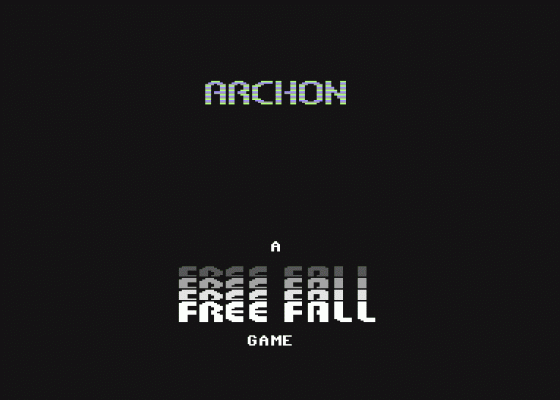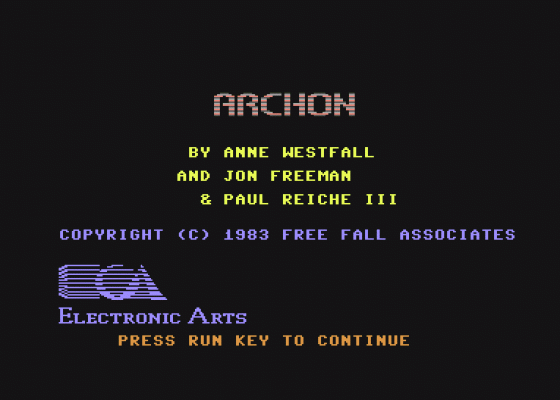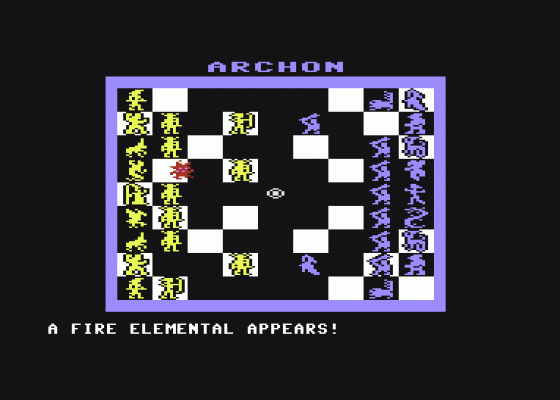
Computer Gamer
 1st July 1985
1st July 1985
Categories: Review: Software
Author: Nick Walker
Publisher: Ariolasoft
Machine: Commodore 64
Published in Computer Gamer #4
Archon is a strategy game based on chess but where each piece is a fantasy creature and every square is fought for on a combat screen. Nick Walker takes an indepth look at this game that's now available for Atari, Amstrad, Commodore 64 and Spectrum computers
Archon
Remember the holographic chess-like game played by C3-P0 and Chewbaca in the film 'Star Wars'. Each game piece was a projected fantasy creature and a dispute for a square results in a real battle between the pieces. They must have been playing Archon.
Archon is a strategy game for the Atari, Commodore 64, Spectrum and Amstrad computers, similar to chess with fantasy role-playing characters as pieces. Set on a 9x9 squares playing board, the object of the game is to control five power points on the board or totally eliminate your opponent's pieces. Unlike chess, two things set Archon apart from other strategy games.
Firstly, the two opposing sides, light and dark, have totally different pieces that, on the whole, are balanced in strength. Secondly, a dispute for a square doesn't result in the defending piece being quietly removed from the board but a separate arcade-like combat arena where the pieces battle it out.
Basic Strategy
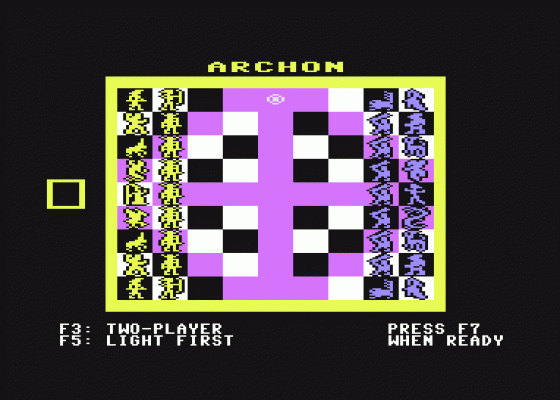
Archon's strategy screen is a board of 9x9 squares, whilst 48 of these are always white or always black, the other 33 vary in brightness from black and white and back continually throughout the game. The strength of a piece in battle is partially dependent on the colour of the square your piece is on. Light side pieces are harder to defeat on light squares than on dark ones. Conversely, dark side pieces are stronger on dark squares and weaker on light ones.
Two important tactics come out of this. Firstly, keep your pieces on their corresponding colour whenever possible. Secondly, launch your attacks so that the peak of conflict is when the 'luminoscity cycle' is to your greatest advantage. Remember the cycle is at its peak for two turns, use both turns to your advantage.
The five power points are indicated on the screen by flashing red symbols, there are four mid-ways of each side of the board and one at the centre. As well as being the points to capture to win the game, these points have strong healing capabilities for weak pieces injured in combat. So even if you don't plan to capture all five immediately it is worthwhile placing a weakened piece on the power points when the luminoscity cycle is in your favour.
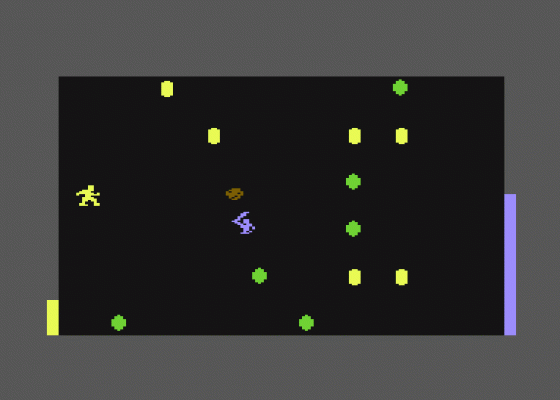
Archon is won or lost in the combat arena, whilst strategy is important, a good player in the combat arena will always beat a good strategist. Action in the combat arena is immediate and simultaneous; there's no taking turns here - victory depends on your arcade skills. Movement around the combat arena is via joysticks and pressing the button readies your weapon and immobilises you, the direction of the attack is then selected with the joystick. Not until the button is *released* will the attack occur.
Combat is of three general types. Knights and Goblins, the pawns of Archon are sword-swingers and club-wielders, they must be within sword or club distane to inflict damage. The Banshee and the Phoenix radiate a circle of fire or a piercing wall respectively, damage is inflicted while the opposing piece is within this circle. There is no need to select a direction for the attack with these pieces. All other pieces throw missiles at various strengths and speeds.
Two vertical bars on each side of the combat screen represent the strength of the battling pieces. When a piece is wounded in battle, its corresponding bar is reduced, when this bar is gone the piece is dead and the battle is over.

As I said earlier, mastery of the combat screen is probably the most important aspect of Archon if, like me, you do not possess lightning reflexes on a joystick there are a number of features you can use to put up a good battle. First and foremost - know the pieces, both your own and the enemy's. each piece has distinct combat abilities, a table of the pieces is given later in this article.
Whilst combat may seem all fast and furious neither you or your opponent can fire fast and continuously, it takes a moment to ready a weapon. The computer rings a bell when you're ready to attack again. Exploit this time to pace your attacks and to find the times when your opponent is unable to retaliate.
Don't be afraid to play the coward on the combat screen, hiding behind rocks until the right moment to launch an attack is often an effective form of combat. This strategy is made all the more effective by the luminoscity cycle that these rocks themselves go through. Normally, a rock is impenetrable, however, for a moment the rocks are the same colour as the background, at this moment it is possible to throw a missile or walk through it.

If you lose a battle, your opponent returns to the strategy screen, launching another attack on the same piece gives it little chance to recover; practice against it until you can consistently beat it with pieces of similar strength.
The Light Side
-
The Wizard
The wizard is an ancient man of vast supernatural powers and the most important piece in the light side. In battle, the wizard throws fairly devastating fireballs, these in my mind are not as effective as a couple of the dark side's strongest pieces, so do all you can to stop attacks from these creatures.
In combat keep him at mid to long distance and in the open, as his fireballs are easily effected by the barriers. Do not move him from the home power point without good reason as this opens him up to the dark side's magic spells and frees the power point. -
Archers
The Archer's arrows are not fast, so she must get close to do serious damage. The archers are ideally suited to take advantage of the luminoscity cycle on the combat screen. Try and pick opponents that are slow and cumbersome to give a greater range. -
Unicorns
The white horse of mythology is probably the strongest piece with a blinding bolt shot of energy from its single horn. Use its speed and fast shooting to stay a long distance from the enemy. Respect its ability and use it for your important battles. -
The Djinni
The Djinni is a magical being from another dimension and the second of the really strong pieces of the light side. In combat, use this piece aggressively and 'Get stuck in'. -
The Phoenix
The Phoenix is a flaming bird of immense size and power. In battle, it explodes to a circular mass of flames, the nearer the enemy is to centre of this fire, the more damage it does, so get as close as possible. The Phoenix cannot be harmed whilst it is generating a fireball, so keep them coming as quickly as possible. -
Valkryies
Valkryies are beautiful blonde war maidens from the legions of Valhalla. The speed of their attacks can be infuriatingly slow, use the rocks to plan your attack when your enemy can't fire back. Tease your opponent into taking a shot at you and then fire back. Avoid open areas. -
Golems
Golems are big, strong, slow and thick. For weapons they tear boulders from the ground; if you manage to get a hit with one of these boulders the damage will be pretty dramatic, so keep trying.
It takes time to rip a boulder from the ground so get in close and be aggressive. At least they are thick skinned enough to take this kind of close combat. -
Knights
I was always taught in chess to never underestimate a pawn; the same is true for the Knights of Archon. While a single blow from one their stronger foe can kill them it is not unknown for a knight to kill the likes of a dragon or manticore.
The secret is to develop an erratic in and attack, out and hide strategy. Do not stay still or move in a straight line for one moment.
The Dark Side
-
The Sorceress
The equal of the old Wizard in power, the Sorceress is eternally young and beautiful. Her lightning bolts are swifter than the Wizard's fireballs making her a more deadly opponent in combat.
Play defensive using the barriers and corners to capture an opponent off guard and then zap them. Don't stray from the black power point without good reason. -
The Basilisk
In many ways, the equal of the light's side Unicorn the Basilisk is a crested reptile. In combat, follow the same guidelines as the Unicorn, using its speed of firing and movement to stay at long range. Interestingly, for a scaled reptile the Basilisk seems more susceptible to damage than the Unicorn. -
Trolls
Trolls are slow-moving creatures that throw rocks, trees or anything else that comes at hand. Get in close and use the fact that Trolls are hard to destroy, to your advantage. -
The Dragon
A monstrous serpentine creature, this piece is in my view the strongest on the entire Archon board. Don't be afraid, find an open piece of ground and use its fast and flaming breath to zap in all eight directions. -
The Shapeshifter
The shapeshifter is a demonic creature that takes the form of anything it attacks. The great problem with this piece is that your opponent is bound to find a way to attack with a lesser piece such as a knight and take out a strong piece with a mere knight.
When using this piece for combat yourself, only pick dark squares and important pieces of the light side. Not one of my favourite pieces. -
Manticores
The Manticore is a cross between a lion and a scorpion, its tail contains an array of spikes which can be thrown at the enemy. These spikes cover a wider area than most other missiles making them difficult for the enemy to avoid.
This makes it useful to have in the front line of any attack and especially effective in wiping out weaker foe. -
Banshees
The Banshee is an undead spirit that attacks with its ferocious wail. My personal favourite the Banshee has the great advantage that once you have initiated an attack you can chase after your fleeing opponent, great fun. The Banshees requires a lot of skill to use successfully but it's worth it. Attack from the side where the wall is at its most effective. -
Goblins
Goblins are hideous creatures of twisted limb and misshaped features. Use the same strategy as for Knights. In Knight/Goblin conflicts it is possible to block an attack with your own sword or club.
Magic
There are seven spells available to each player, only the mages of each side, the Wizard and Sorceress can cast spells. The same spells are available for both sides and spells cannot effect power points. Magic is probably the greatest factor in strategy, each spell can only be used once, so timing is critical.
The Spells
-
Teleport
This spell teleports any one of your pieces, any distance to another square. This spell is useful in the early stage if the game as an aggressive opening for transporting a powerful piece to the rank and file of the enemy, to destroy as many pieces as possible before your opponent has time to move them to the safety of their corresponding colour. Alternatively, later in the game the spell could be used to transport a powerful piece to the hub of a battle or to remove a wounded piece for the scene of a battle. -
Heal
This spell instantly heals any piece of any wounds it has sustained in the combat arena. Do not waste it on pieces over power points or on pieces unlikely to be attacked in the near future. Never heal the Shapeshifter as it regenerates for each battle. -
Shift Time
This spell has two possible effects. Normally it reverses the flow of the luninoscity cycle; however, if it is cast at peak lightness or peak darkness, the cycle will be shifted to the opposite extreme. Its uses are many and varied, use it to extend the lengthen of imprisonment (see imprisonment spell below) to stop the advantage of an attack or lengthen the time available for your own attack. To really upset someone, use it to change the luminoscity cycle at the peak of an attack. Don't be tempted to apply Shift Time immediately after your opponent; if ou withstand their use of it you will be in a much stronger position. -
Exchange
This spell causes any two pieces on the board to change places. Use it to frustrate your opponent by swapping an aggressively placed piece with a more innocuous one. -
Revive
This spell restores a piece killed in a previous combat. Restore only strong pieces and avoid placing them on an unfavourable square or it may be killed again immediately. -
Summon Elemental
This spell lets you generate a temporary adversary in an attempt to kill off a particularly troublesome piece. Along with the spell Imprison, these two are the spells you really must cast at a mage that has wandered from its power point.
There are four elementals: earth, air, water and fire. As far as combat is concerned treat Earth as a Troll, Fire as a wizard, Air as an Archer and Water as a Manticore. There's no point being particularly cautious with an elemental, there's no way it will be around after the battle. -
Imprison
This spell pins an icon down to the square it is on, when the spell is cast. The spell only lasts until the luminoscity reaches maximum brightness or darkness for the piece on an unfavourable square whilst you finish it off or to blunt an attack.
Prices And Conclusion
To beat a good placer or for that matter the computer at Archon, the key is concentration. Exploit every facet of the game that gives you an advantage, no matter how small. Archon is available for the Spectrum, Atari, Commodore 64 and Amstrad, the review was written based on the Atari disk-based version. Some slight differences appear between the three versions.
On cassette, Archon costs around £11.95 on disc for the Commodore 64 or Atari it costs £14.95, and it's worth every penny.
Other Reviews Of Archon: The Light And The Dark For The Commodore 64
Archon
A review by Bryan Skinner (Personal Computer News)
Archon (Ariolasoft)
A review

